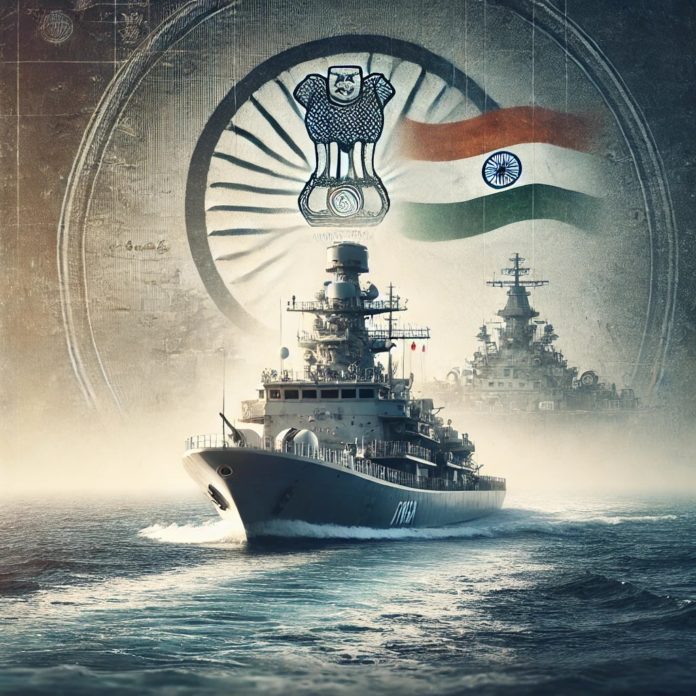As India is slated to celebrate its 77th Navy Day on 4 December, we reflect on the extraordinary evolution of the Indian Navy — a force that has grown from its modest beginnings into one of the world’s most distinguished maritime powers. Once dubbed the “Cinderella Service” due to its early challenges, the Navy has come into its own, representing India’s philosophy of Vasudhaiva Kutumbakam (The World is One Family). Today, the Indian Navy is more than just a guardian of the nation’s shores; it stands as a force for humanitarian aid, regional stability, and diplomatic goodwill, embodying the professionalism and compassion that define India’s global aspirations.
A Legacy of Transformation and Resilience
India’s post-independence approach to its naval forces initially prioritised peace and diplomacy, relying heavily on foreign-built vessels to protect its maritime interests. However, as regional dynamics evolved, so did India’s naval ambitions. Recognising the strategic value of an autonomous Navy, the government nationalised key shipyards, such as Mazagon Dock Shipbuilders Limited, laying the foundation for a self-reliant naval defence.
A pivotal milestone in this journey was the construction of the Godavari-class frigate in the 1980s — India’s first indigenously built warship. This achievement was not merely a technical feat; it signified a commitment to indigenous innovation and sovereignty over India’s maritime future. Today, this legacy lives on in advanced warships and submarines, with the iconic aircraft carrier INS Vikrant epitomising the Navy’s world-class technological capability and its role as a pillar of India’s defence policy.
Strategic Modernisation and Expanding Reach
The publication of India’s first Maritime Doctrine in 2004 marked a transformative shift in strategy, expanding the Navy’s focus from coastal defence to ensuring security across the Indian Ocean Region (IOR). By 2009, an updated doctrine addressed the shifting power dynamics in the region, notably China’s growing influence. This strategy includes high-impact assets like the nuclear-powered ballistic missile submarine INS Arihant, which enhances India’s deterrence capabilities and solidifies the Navy’s stature as a core element of India’s defence.
Recently, the Indian Navy underscored its operational readiness through a historic dual aircraft carrier exercise involving INS Vikrant and INS Vikramaditya. This rare capability places India among an elite cadre of nations, demonstrating the Navy’s formidable power projection in the Indian Ocean. The seamless coordination of such an exercise speaks to the Navy’s operational mastery, affirming India’s dedication to safeguarding its maritime domain.
Indigenous Development: Strength through Self-Reliance
The Navy’s commitment to self-reliance has yielded extraordinary innovations, such as the Kalvari-class submarines and the supersonic BrahMos missile system, showcasing India’s prowess in advanced defence technology. Supported by the Atmanirbhar Bharat (Self-Reliant India) initiative, partnerships between the Defence Research and Development Organisation (DRDO), public-sector shipyards, and private firms have bolstered the Navy’s capacity to design and produce cutting-edge assets. By integrating indigenous and international technology, the Navy aligns its growth with India’s strategic objectives, cementing its role as a stabilising force in the IOR.
Humanitarian Assistance and Disaster Relief (HADR): A Commitment to Compassion
Beyond its defensive role, the Indian Navy has emerged as a first responder across the Indian Ocean in times of humanitarian crisis, underscoring India’s commitment to regional stability and compassion. Following the devastating 2004 Indian Ocean tsunami, the Navy provided vital assistance to Sri Lanka, the Maldives, and Indonesia, strengthening India’s role as a compassionate power. Since then, the Navy has led numerous high-impact missions, including Operation Maitri in Nepal after the 2015 earthquake and the evacuation of civilians from war-torn Lebanon in 2006.
These HADR missions highlight the Navy’s readiness to respond swiftly and effectively to disasters, leveraging advanced tools like satellite communication and unmanned aerial vehicles (UAVs). This capability solidifies India’s reputation as a regional stabiliser, proving that compassion and responsibility are at the heart of its naval doctrine.
Inclusivity Milestones: Championing Gender Equality
The Indian Navy has consistently broken barriers in traditionally male-dominated roles, leading the way in gender inclusivity. This year, Sub Lieutenant Anamika B. Rajeev made history as the Navy’s first woman helicopter pilot, a powerful symbol of Nari Shakti (women’s empowerment) in the armed forces. Additionally, an all-women crew aboard INSV Tarini completed an inspiring global circumnavigation, reinforcing the Navy’s commitment to gender equality.
The Navy’s journey toward inclusivity began in the 1990s, welcoming women into branches like the Medical and Education Corps. Today, women take on advanced roles across aviation, navigation, and command, backed by dedicated training and mentorship initiatives. These strides in gender equality represent not just a progressive outlook but a commitment to harnessing the talent and ambition of all Indians, regardless of gender.
Diplomatic Reach and Soft Power
The Navy also plays a pivotal role in India’s diplomatic initiatives, particularly through strategic alliances like the Quadrilateral Security Dialogue (Quad) with the United States, Japan, and Australia. By participating in joint exercises under the Quad framework, the Navy strengthens regional security and counters challenges posed by rising global tensions. In the Gulf of Aden, it has successfully thwarted piracy, ensuring the safe passage of commercial vessels and reinforcing India’s image as a trustworthy maritime ally.
Through these diplomatic and security missions, the Navy enhances India’s global standing as a partner committed to the principles of peace, cooperation, and regional stability, furthering India’s role as a “net security provider” for the IOR.
Environmental Sustainability and Future Prospects
Reflecting India’s dedication to sustainable development, the Navy has prioritised eco-friendly practices within its operations. Energy-efficient systems, carbon emission reductions, and adopting renewable energy solutions align the Navy with global environmental standards. Many ships now feature seawater distillation capabilities, providing potable water in disaster scenarios — a practical and forward-thinking adaptation.
Looking ahead, the Navy aims to expand its fleet and transnational capabilities while exploring new roles for women in critical areas such as submarine operations and aircraft carrier deployments. Guided by the principles of self-reliance and regional security, these developments ensure that the Navy will continue to play a central role in India’s defence and diplomatic strategies.
A Legacy of Excellence and Integrity
The journey of the Indian Navy from a modest coastal force to a formidable maritime power is a testament to resilience, innovation, and a commitment to the greater good. As India looks toward the future, the Navy stands as a symbol of national pride, embodying values of professionalism, compassion, and inclusivity.
With each milestone, the Navy strengthens its legacy as a protector of the seas and a beacon of India’s aspirations. On this Navy Day, as we honour the men and women who serve, we celebrate a force representing India’s dedication to peace, progress, and the betterment of humanity.

